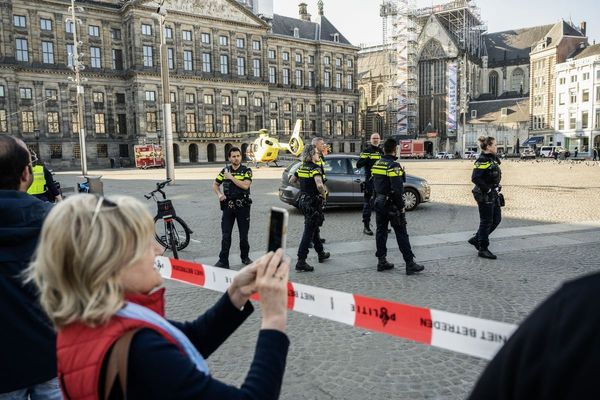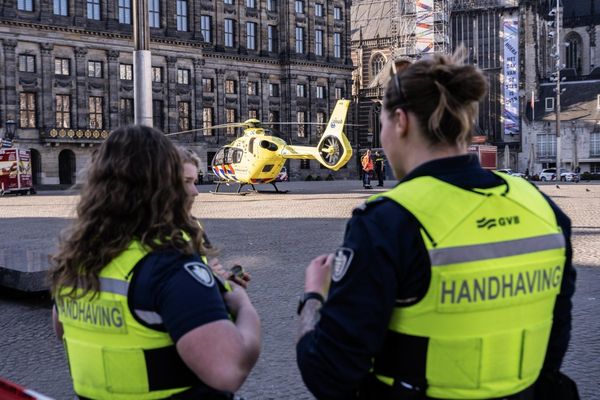
Sebastião Salgado’s jaw-dropping images of the world’s largest rainforest are renowned for leaving viewers stunned. That’s largely been the case at the Brazilian photographer’s latest exhibition, Amazônia, which is showing at Barcelona’s royal dockyard museum. The 200 large-print photographs – each luminously lit, as though by a shaft of light penetrating the forest gloom – range from soaring mountains and storm-laden skies (“flying rivers”) through to spear-carrying native peoples mid-hunt.
But they haven’t pleased everyone. Refusing the curator’s invitation to “feel enveloped by the forest”, João Paulo Barreto, an anthropologist from Brazil’s Yé’pá Mahsã (or Tukano) ethnic group, walked out after just 15 minutes, visibly distressed after visiting the exhibition shortly after its opening last month.
“I couldn’t stand it,” he says. “For me, it feels such a violent depiction of Indigenous bodies. I mean, would Europeans ever deign to exhibit the bodies of their mothers, of their children in this way?”
Barreto’s objections were directed towards the portraits of his fellow Indigenous “kinspeople” in naive or suggestive poses with little or no attire. While authentic to some forest settings, he argues that such images perpetuate the “primitivisation” of Indigenous peoples when reproduced in public.
Among the notable examples is a staged photo of half a dozen women of the Suruwahá people, surrounded by about 20 of their offspring, from suckling babies to young adolescents, almost all of whom are naked. The same series contains a picture of Hatiri, one of the young teenage girls from the group, bathing topless in a backwater stream; it is an Eden-like scene, with the naked protagonist preternaturally lit in the foreground, set against a backdrop of towering virgin forest behind.
Barreto sees the same “optics of romanticism” redolent in this photograph (which features as the title image on some of the exhibition’s publicity materials) repeatedly in evidence: in the naked Zo’é women playing in a set of rapids; in the young mother breastfeeding her child; in bare-bottomed boys leaping from a canoe.
His is not a lone voice. Barreto’s views are echoed by a growing wave of Indigenous critics who complain about the exoticised way in which non-native photographers continue to portray their communities.
The fact that Salgado is eliciting their growing ire shouldn’t be surprising. His deployment of black-and-white imagery and dramatic lighting, coupled with powerful human-centred storytelling around hard-hitting social themes, has made him one of the world’s best-known documentary photographers. His instantly recognisable style has also won him wide critical acclaim. Author of multiple bestselling books and the subject of a documentary film co-directed by German film-maker Wim Wenders, Salgado is an honorary member of the Academy of Arts and Sciences in the United States and winner of multiple international prizes, including for outstanding contribution at the 2024 Sony world photography awards.
Amazônia marks the culmination of an engagement with the region that stretches back to the early part of Salgado’s more-than-50-year career. The rainforest provided the backdrop to his striking images of Brazil’s anthill-like Serra Pelada mine that first shot him to fame in 1986, whereas the name of the Paris-based photography agency he set up in 1994 after a 15-year stint with Magnum Photos is Amazonas Images.
Speaking about his current exhibition, Salgado, now 80, repeatedly emphasises the need to preserve the Amazon rainforest and its native populations against external threats. “The heart is there yet,” an optimistic Salgado told this newspaper three years ago. “To show this pristine place, I photograph Amazônia alive, not the dead Amazônia.”
Yet while few doubt Salgado’s mastery behind the lens, discomfort around his representation of the Amazon has been slowly bubbling. Back in 2016, for instance, a group of academics at Brazil’s Federal University of Acre condemned his tendency to locate Indigenous people in an “immutable” prehistory that rejects ideas of “progress”.
The alleged objectification and, in some cases, eroticisation of Salgado’s Indigenous subjects also drew fire in a 2022 article for the Brazilian version of Le Monde Diplomatique, in which writer Mirna Wabi-Sabi criticised the photographer’s depiction of nudity as “pure and naive”. “Some argue that the sexualisation of nudity happens in the eye of the audience, not of the photographer, but there are artistic decisions that Salgado has made in which sexualisation is obvious,” she states.
By way of example, she cites the photograph of a young Zo’é woman lying unclothed in a hammock. Pictured in repose, she is shown looking directly into the camera, her arms stretched above her head and her knees bent upwards.
It perhaps doesn’t help Salgado’s cause that, less than 10 blocks from where his one-man show is on until April, a rival exhibition about Amazonia is taking place at the Centre for Contemporary Culture of Barcelona (CCCB). Daiara Hori Figueroa Sampaio, one of many artists featured in the CCCB show, argues that Salgado’s work reinforces colonial-era stereotypes of native communities as objects of research.
“It’s exactly this kind of representation that we urgently need to deconstruct,” says Sampaio. “Personally, I just can’t understand why a person in the 21st century would want to take photos as if they were in the 19th century … other than some kind of fetish for colonialism.”
Four years in the making, CCCB’s exhibition, entitled Amazons: The Ancestral Future, adopts a markedly different tack. Not only has it been produced in close cooperation with a range of Amazonian artists and cultural leaders, but its perspective of the Amazon is unmistakably modern and diverse. Despite the persistent stereotype of the world’s largest rainforest as a pristine wilderness, roughly 24 million of the region’s almost 30 million inhabitants live in towns or cities, explains CCCB director Judit Carrera. Moreover, only about 1.5 million define themselves as Indigenous.
“The idea is to portray the huge complexity of the Amazon today and break down the usual way of looking at the Amazon from the west,” Carrera says. “So our approach has been to let Amazonians speak for themselves, and show as much as possible this enormous diversity of ecosystems, cultures, languages, demographics.”
In the show, the sheer polarity of realities in the Amazon region – an area almost the size of Australia – is illustrated by the inclusion of both a replica maloca, or ancestral long house, and a poster-strewn riverside bar from the city of Iquitos in the Peruvian Amazon.
Equally striking is a remarkable collection of photographic collages by the Brazilian visual artist Gê Viana. The works take traditional imagery of her native Anapuru people and layer it on to digital portraits of present-day individuals, creating a powerful juxtaposition between old and new, imagined and real.
Rember Yahuarcani has a similarly eye-catching series of pieces reflecting the myths and memories of the White Heron clan, of his Witoto Indigenous nation. One of more than 50 Amazonian artists involved in the CCCB exhibition, Yahuarcani – who also goes by the Witoto name, Ribetɨaɨ – insists that all artistic production from within the Amazon is, by its nature, political.
“The artistic spaces of the west represent established powers and the hegemony of the market and so forth. We can’t escape these influences … but we can enter these spaces with a provocation that enables us to do things differently,” he states.
The same reason explains why the self-taught Yahuarcani, whose paintings dazzle with electric colour, decries the black and white aesthetic championed by Salgado, which he says serves to place Indigenous people in an unchanging and inescapable past.
He also echoes widely shared discomfort at Salgado’s frequent depiction of women and children in full or partial nakedness. “Picturing women, children, grandmothers naked and then presenting them as somehow exotic can have huge collateral damage because it feeds historic stereotypes that have caused huge harm to Indigenous communities in the past,” he explains.
Yahuarcani does not only single out Salgado. The use of images of Amazon’s Indigenous peoples without their knowledge or consent is so widespread in international artistic and cultural circles as to be “almost invisible”, he says. He cites the example of a major art fair in Madrid a number of years ago, where a portrait of an elderly Indigenous woman taken by the Lima-based photographer Javier Silva Meinel appeared on a series of large-scale posters along one of the Spanish capital’s main throughfares.
“It was this enormous picture of her face in black and white, yet with only the name of the photographer and the dates of the art fair,” he recalls. “The grandmother was made absolutely invisible. We didn’t know her name, her community, if she was dead or alive – nothing.”










